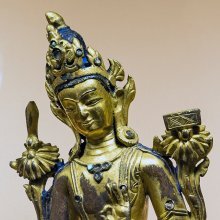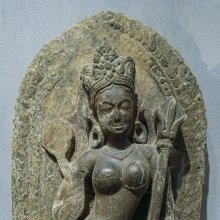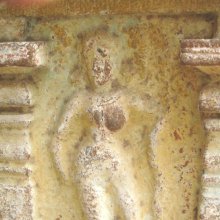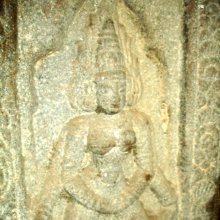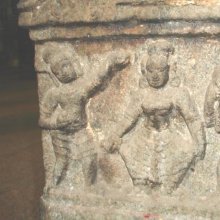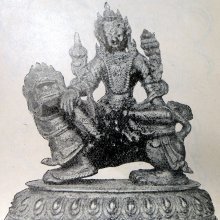Graceful: 2 definitions
Introduction:
Graceful means something in Hinduism, Sanskrit. If you want to know the exact meaning, history, etymology or English translation of this term then check out the descriptions on this page. Add your comment or reference to a book if you want to contribute to this summary article.
Images (photo gallery)
(+7 more images available)
In Hinduism
Natyashastra (theatrics and dramaturgy)
Source: Shodhganga: Elements of Art and Architecture in the Trtiyakhanda of the Visnudharmottarapurana (natya)Graceful looks are associated with Śṛṅgāra-gati: one of the various Gatis (“way of walking”) (in Indian Dramas), according to the Viṣṇudharmottarapurāṇa, an ancient Sanskrit text which (being encyclopedic in nature) deals with a variety of cultural topics such as arts, architecture, music, grammar and astronomy.—A person in elegant and stylish dress up walks in rhythmic footsteps with particular movements of arms along with the legs. One looks very graceful in it and it is generally adopted at the time of meeting with the beloved. That is why this type of gait is related to śṛṅgāra i.e., love. Moreover, this type of gait is seen in the walking of Dūtī i.e., female messenger.

Natyashastra (नाट्यशास्त्र, nāṭyaśāstra) refers to both the ancient Indian tradition (shastra) of performing arts, (natya—theatrics, drama, dance, music), as well as the name of a Sanskrit work dealing with these subjects. It also teaches the rules for composing Dramatic plays (nataka), construction and performance of Theater, and Poetic works (kavya).
Shilpashastra (iconography)
Source: Shodhganga: Elements of Art and Architecture in the Trtiyakhanda of the Visnudharmottarapurana (shilpa)1) The Graceful appearance (of a portrait) is denoted by the Sanskrit term Lāvaṇyayojana and represents one of the six limbs of Painting (citra), according to the Kāmasūtra and Viṣṇudharmottarapurāṇa, an ancient Sanskrit text which (being encyclopedic in nature) deals with a variety of cultural topics such as arts, architecture, music, grammar and astronomy.—Lāvaṇyayojana denotes graceful appearance of a portrait. In the context of lāvaṇya, the Ujjvalanīlamaṇi states that lāvaṇya is that which is reflected through the natural purity of limbs as like the luster reflects from the pearl in a natural way. This means the execution of luster and gracefulness in a picture is totally based on the spontaneous flowing of an artist’s emotion. So it can be said that to make a portrait more charming and lively, the addition of gracefulness is very important.
2) Graceful looks are associated with the Commander, who follows specific guidelines in the tradition of ancient Indian Painting (citra).—In the Viṣṇudharmottarapurāṇa, the rules of Painting of different classes have been elaborately discussed. The picture of the commander should be very graceful having a big head, wide chest, big nose, prominent chin, huge shoulders, clear hands and neck, forehead with three layers and great waist and his sight should be as sharp as an eagle.

Shilpashastra (शिल्पशास्त्र, śilpaśāstra) represents the ancient Indian science (shastra) of creative arts (shilpa) such as sculpture, iconography and painting. Closely related to Vastushastra (architecture), they often share the same literature.
See also (Relevant definitions)
Starts with: Graceful buttercup, Graceful cinquefoil, Graceful gelsemium, Graceful sedge, Gracefulness.
Full-text (+434): Caracana, Hamsagamini, Caracuncu, Vagvilasa, Gojiravana, Chabakada, Makulavana, Goragomata, Shabdasaushthava, Elirkai, Narmasphurja, Suga, Kaishiki, Lalita, Hela, Graceful buttercup, Gojira, Graceful sedge, Vilasamdal, Graceful cinquefoil.
Relevant text
Search found 145 books and stories containing Graceful; (plurals include: Gracefuls). You can also click to the full overview containing English textual excerpts. Below are direct links for the most relevant articles:
Garga Samhita (English) (by Danavir Goswami)
Verse 4.4.3 < [Chapter 4 - The Story of the Kauśalā Women]
Verse 4.13.13 < [Chapter 13 - The Story of the Demigoddesses]
Verse 8.13.108 < [Chapter 13 - A Thousand Names of Lord Balarāma]
Dasarupaka (critical study) (by Anuru Ranjan Mishra)
Part 3-6 - Bhāṇa rules < [Chapter 2 - Bhāṇa (critical study)]
Part 9 - Sentiments (rasa) used in a monologue (Bhāṇa) < [Chapter 2 - Bhāṇa (critical study)]
Part 3-6 - Vyāyoga rules < [Chapter 5 - Vyāyoga (critical study)]
Song 10 < [Advaita-tattwa-kathana (Description of the Truth of Lord Advaita)]
Song 28 < [Kaiśora-Līlā, Prabhura Dvitīya-vivāha (The Lord’s Second Wedding)]
Song 11 < [Nityānanda-milana (Meeting Lord Nityānanda)]
Gati in Theory and Practice (by Dr. Sujatha Mohan)
Analysis of technical terms: Tāṇḍava and Lāsya < [Chapter 1 - Nāṭya]
Gati in Vṛttis and Pravṛttis < [Chapter 3 - Application of gati in Dṛśya-kāvyas]
Nāṭṭupura Naḍanam < [Chapter 4 - Practice of Gati]
Pallava period (Social and Cultural History) (by S. Krishnamurthy)
Dancing girls in temples < [Chapter 3 - Socio-Religious Life]
Conclusion (Social Life) < [Chapter 5 - Conclusion]
Weapons and Warfare < [Chapter 4 - Material Culture of the People]
